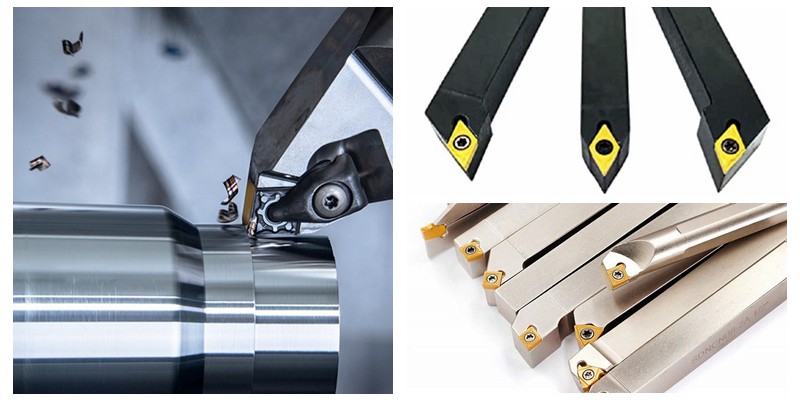- September 23, 2022
Lathe cutting tools are tools mounted on a lathe (wood/hand/ CNC) applicable in producing turned parts. They move along the lathe’s axis, and their path determines the workpiece’s final shape.
There are several lathe non-CNC and CNC, each type with unique features and designs that determines supported lathe cutting operation and outright applications. As a result, choosing the right cutting tool requires an in-depth understanding of the tool. This article talks about common tools for the lathe, their design, features, and applications. Let’s get right to it.
Get high-quality, tight tolerances custom turned parts delivered on time. Discover the perfect CNC machining solution for your manufacturing needs today.
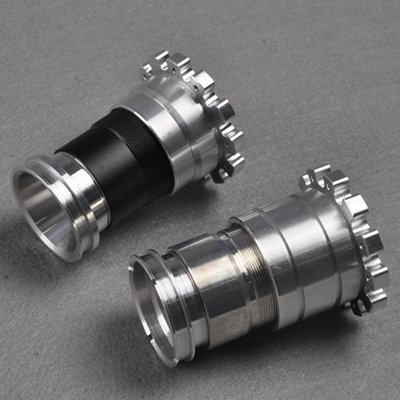
Four Categories: Types of Lathe Cutting Tools
Many types of cutting tools used on a lathe or CNC lathe are groupable into four main categories: materials, operations, structure, and feed direction. Below are the different lathe cutting tools that fall under each category.
Category 1: Lathe Cutting Tools Based on Material
Many materials are suitable for making tools used on a lathe, each with unique characteristics. As a result, each lathe cutting tool has properties based on the material’s inherent mechanical properties. Below are the common lathe cutting tools based on the material used.

High-speed Steel(HSS)
High-speed steel contains elements like tungsten, carbon, vanadium, and chromium. Cutting tools made using this material are known for their extreme hardness, strength, and wear/heat resistance. Furthermore, they have high speed suitable for rough and semi-finish machining.

Carbide
Carbide lathe cutting tools are hard and brittle. Therefore, they are compatible with virtually all materials. However, they are expensive, making their use limited in part manufacturing.

Diamond
Lathe cutting tools made from diamonds are very hard. As a result, they are suitable for working with all materials. Nevertheless, like carbide tools, they are costly, which limits their industrial application.

Cubic Boron Nitride
Cubic Boron Nitride is the next in line in terms of hardness. They are durable, abrasion resistant, and suitable for rough machining and intermittent cutting, especially workpiece cast iron.
Category 2: Lathe Cutting Tools Based on Operations
Lathe cutting tools are also categorized based on the machining operation. Below are the common tools used in each lathing operation.
Turning tools
Turning tools are applicable in removing materials along the length of a workpiece. Consequently, it leads to a reduction in the diameter of the workpiece. There are two types:
–Rough turning tools: Rough turning tools are those that are used to remove large amounts of material from a workpiece in a single pass. Therefore, they are typically used to create rough shapes or to prepare surfaces for subsequent finishing operations.
–Finish turning tools: Finish turning tools are used to remove small amounts of material from a workpiece in order to create a smooth, finished surface.
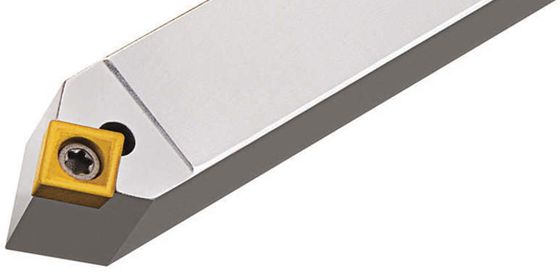
Chamfering tools
These lathes’ cutting tools are suitable for chamfering, i.e., producing a slanting edge. Turning tools are also suitable for chamfering. However, they must be set at the right angle to the workpiece. Moreover, they become obsolete when the inclination angle is high.
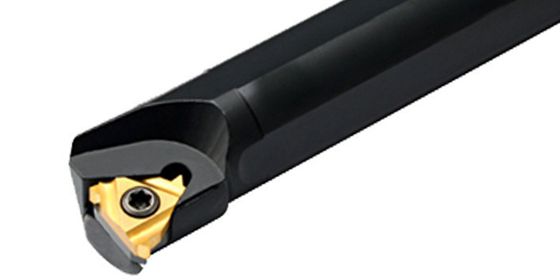
Thread Cutting tools
Thread cutting tools are suitable for making spiral thread patterns on cylindrical parts. Generally, they have a nose angle that depends on the intending thread angle. Furthermore, the tool’s cross-section will affect the thread’s pitch.
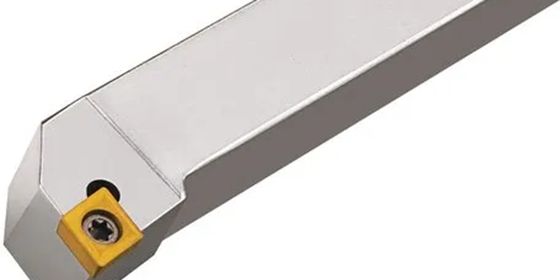
Facing tools
Facing tools utilizes the side cutting edge to remove the thin layer of materials and produce a smooth surface.
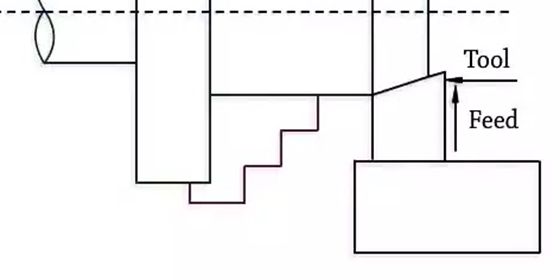
Forming tools
A forming tool combines a turning and grooving tool applicable in making complex shapes at a go. While the turning tool will do the same job, a forming tool is ideal as it increases accuracy and reduces cycle time.

Grooving tools
These tools are applicable in making grooves on a workpiece with cylindrical surfaces. There are several shapes of grooves determined by the lathes machine tool shape. Common ones are V-shaped and square cutting tools.
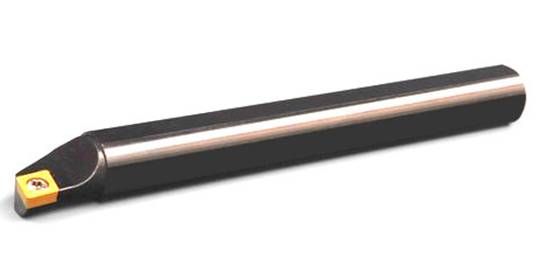
Boring tools
A boring tool is a cutting tool characterized by a boring bar with a cutting tool at its end. So, it is applicable in working and increasing the diameter of a hole.
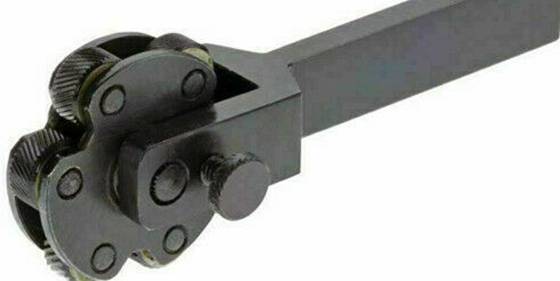
Knurling tools
Knurling tools have two or more metal rolling wheels with embossed patterns. Usually, they are applicable in making indents on a workpiece to increase its grips.
Category 3: Lathe Cutting Tools Based on Structure
There are three major types of lathe cutting tools based on their structure. They are:
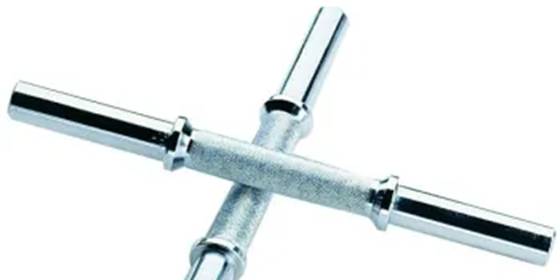
Single Body tools
They come from a single piece of material and are designed to have a specific shape, size, and geometry. As a result, they are the most common lathe machine tools for their speed and strength.
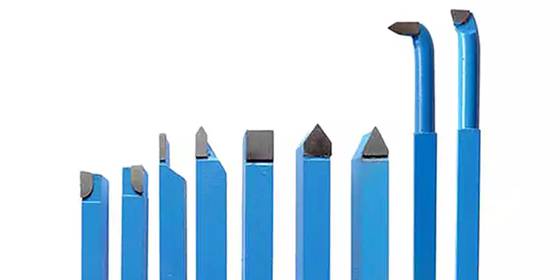
Welding lathe cutting tools
These tools have a head and rod made from different materials joined via welding. Generally, the flank comes from materials such as carbide, known for its strength and durability, while the body can come from different metals. Due to the material difference, they deliver less cutting force than single-body tools.
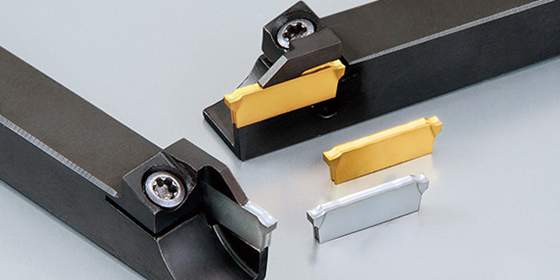
Clamp lathe cutting tools
These cutting tools are similar in material composition to welding tools. However, instead of a welding tool, the clamp lathe tool is formed by placing the insert (i.e., the cutting tool) on a handlebar. Generally, clamp lathe cutting tools are dexterous and replaceable. Therefore, their properties, such as strength and durability, depending on the type of inserts.
Category 4: Lathe Cutting Tools Based on Feed Direction
There are three major types of lathe cutting tools based on feed direction. They are:
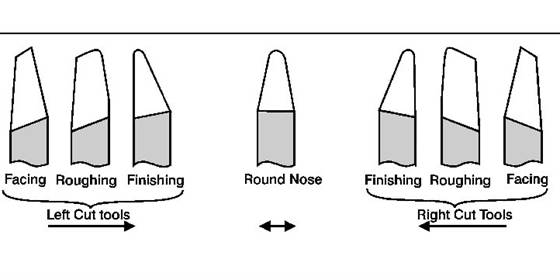
Right-Hand lathe cutting tools
These tools remove materials when transporting them from right to left. They have a design similar to the human hand. This is because the right thumb indicates the direction of the feed, and the main cutting edge is on the left side of the tool.
Left-Hand lathe cutting tools
These tools remove materials when transporting them from left to right. According to the human hand design, the left thumb denotes the feed direction, and the main cutting edge is on the right side of the tool.
Round Nose Lathe Cutting Tools
These tools can move from left to right or right to left as they have no side rake and back rake angles. They are suitable for machining operations that require a smooth surface.
Please Note: There are other lathe cutting tools with different applications. You should ensure you talk to a professional CNC machinist or contact WayKen on the perfect one.
How to Select the Right Lathe Cutting Tool?
We all know that the perfect job needs the right tools. Selecting the right lathe cutting tool is very important to get accurate results on a workpiece. Below is a list of ways you can choose the right lathe cutting tool:
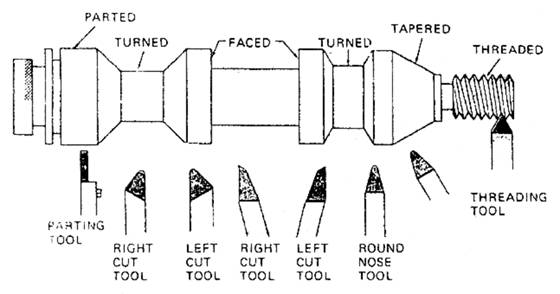
Lathe Tools Coating
Coatings are materials applied to the external parts of a cutting tool to increase its mechanical properties and aesthetics. Furthermore, they are important as coated lathe cutting tools last longer than uncoated tools. As expected, there are several coatings, including Titanium Nitride(TiN), Titanium Carbide (TiC), and Aluminum Oxide, each with their inherent properties.
Workpiece Material
The mechanical properties of the workpiece will play a huge role in choosing the right lathing cutting tool. The most basic selection process depends on hardness, as hard materials should only be turned with hard-coated or uncoated tools. This will prevent the chipping of the tools during the machining operation. For example, cutting tools made from diamond and Cubic Boron Nitride are known for their strength and suitability for hard materials.
Desired Turning Operation Types
Each lathing operation requires a specific set of skills and tooling. As a result, you should ensure you choose the right tool based on the operation. For example, turning tools are applicable in removing materials along the length of a workpiece. However, they are not the right ones for forming operations. Other consideration includes the cutting direction.
Required Part Shape
Also, consider the tool and part shape when selecting a lathe cutting tool. For example, during facing operations, when you want to create a cube shape on a material, you can use a rectangular facing tool.
Components of A Lathe Cutting Tool
Although lathe machine tools have different designs for their functions and applications, they all have specific parts in common. Below are the parts commons to every type of lathe cutting tool.
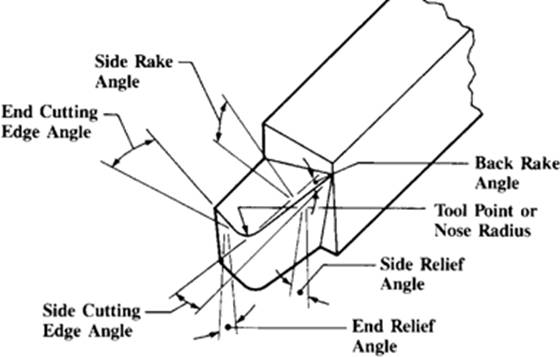
Shank
This is the part connected to the lathe. It is the thickest part of the tool, with mostly a rectangular cross-section.
Face
This is the part of the lathe cutting tool on which the chip flows during lathing operations.
Flank
This is the part that opposes and interacts with the workpiece. It can be major or minor and, together with the side of the cutting tool, forms the cutting edge.
Cutting Edge
This part is responsible for the tool’s cutting action. The cutting edge depends on the tool. For example, a single-point tool will have two cutting edges and can be cut using the two surfaces.
Tool Nose
This is the main and minor cutting-edge intersection. It has a curvature that increases its strength, longevity, and ability to make a smoother cut.
Side Rake Angle
This is formed by the tool face and line perpendicular to the body. It determines the direction of the chip flow.
Side Relief Angle
When looking from the front, the side relief angle is the angle made by the major flank with the shank surface perpendicular to the cutting tool’s base. It prevents the major flank from rubbing against the workpiece.
End Relief Angle
When looking from the side, it is the angle of the flank leading edge made with the line normal to the tool’s base. It prevents the minor flank from rubbing against the workpiece.
Back Rake Angle
It is the angle between the face and a plane parallel to the base. A high rake angle will increase sharpness but decrease strength and vice versa.
End Cutting Edge Angle
This is the angle the end cutting edge makes with a line perpendicular to the tool’s body and tangent to the nose. It prevents the tool from touching the workpiece’s machined surface.
Side Cutting Edge Angle
The angle the side cutting edge makes with a line parallel to the tool’s body. Therefore, it plays an important role in the cutting force and chip thickness during lathing operations.
Available Cutting Tool Operations for A Lathe
A lathe can perform various machine operations. Below are the most common cutting tool operations you can perform on a workpiece.
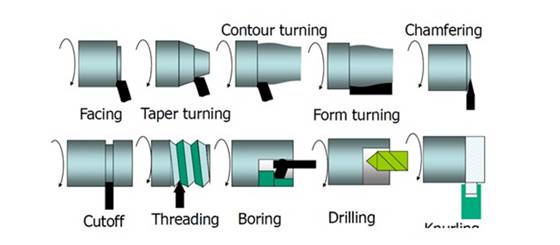
Turning Tool Operations
Turning is the most common cutting tool operation in machining. It involves creating a cylindrical part of a precise geometry by removing excess materials from the workpiece. In general, this can be automated in CNC turning or manual, as seen in other lathing operations.
Facing Operation
This cutting operation involves reducing the workpiece length to form the desired parts. It involves using the cutting tool to cut off the part perpendicularly.
Chamfering Operation
This involves producing a canted surface on the cylindrical workpiece edge. It is applicable in reducing damages done to sharp edges
Knurling Operation
Knurling involves using two or more metal rolling wheels to create embossed patterns on a cylindrical workpiece. Therefore, it is applicable in increasing the grips of a product.
WayKen Will Meet Your Various Machining Needs
There’s no need to worry about choosing the right lathe cutting tools when you can simply get a team of experts to do it for you. WayKen is your one-stop shop for all your machining needs. We offer a variety of CNC turning services, including facing, chamfering, knurling, etc. Whether you need a prototype or low-volume machined parts, you can be sure to get high-quality production parts. Just upload your CAD files today, and you will get an instant quote and free DFM.
Conclusion
Lathe cutters are crucial tools in CNC machining. They come in different types, which determines their operations and functions. As a result, choosing the right tool is important for a successful machining operation.
FAQ
What are the functions of lathe cutting tools?
Lathe cutting tools function in the cutting part of a workpiece to give a required shape. Cutting the parts can occur via several operations such as chamfering, and turning.
What are the properties to be considered before choosing a lathe cutting tool material?
When you want to select the material of a lathe cutting tool, you need to check for its hardness, toughness, and heat resistance.
Which of the cutting tool materials has the highest quality?
Because of their hardness and cutting speed, diamond lathe cutting tools are the best. However, they are costly, which limits their industrial use.

